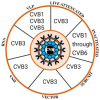Vaccines against Group B Coxsackieviruses and Their Importance
- PMID: 36851152
- PMCID: PMC9961666
- DOI: 10.3390/vaccines11020274
Vaccines against Group B Coxsackieviruses and Their Importance
Abstract
The group B coxsackieviruses (CVBs) exist in six serotypes (CVB1 to CVB6). Disease associations have been reported for most serotypes, and multiple serotypes can cause similar diseases. For example, CVB1, CVB3, and CVB5 are generally implicated in the causation of myocarditis, whereas CVB1 and CVB4 could accelerate the development of type 1 diabetes (T1D). Yet, no vaccines against these viruses are currently available. In this review, we have analyzed the attributes of experimentally tested vaccines and discussed their merits and demerits or limitations, as well as their impact in preventing infections, most importantly myocarditis and T1D.
Keywords: coxsackieviruses; type 1 diabetes; vaccine; viral insulitis; viral myocarditis.
Conflict of interest statement
The Board of Regents of the University of Nebraska is an applicant for a pending provisional patent application (# 63/179,980). NL, and JR are listed as inventors on the pending patent application and the inventors have contributed to the creation and use of the Mt10 vaccine virus described in this review. All other authors declare no conflict of interest.
Figures


References
-
- Pozzetto B., Gaudin O.G. Encyclopedia of Virology. Elsevier; Amsterdam, The Netherlands: 1999. Coxsackieviruses (Picornaviridae) pp. 305–311. - DOI
Publication types
Grants and funding
LinkOut - more resources
Full Text Sources
Other Literature Sources

